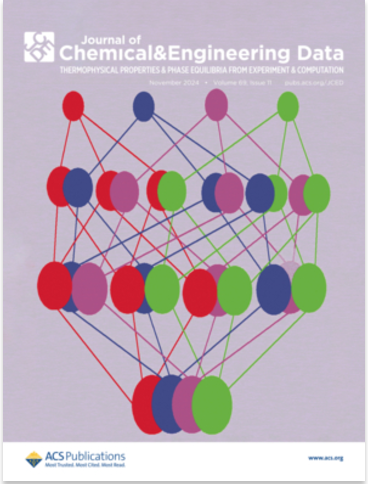切除黑色素瘤的个体化新抗原疗法 mRNA-4157 (V940) 加 pembrolizumab:mRNA-4157-P201 (KEYNOTE-942) 试验的 3 年更新。
IF 2.1
3区 工程技术
Q3 CHEMISTRY, MULTIDISCIPLINARY
Journal of Chemical & Engineering Data
Pub Date : 2024-06-10
DOI:10.1200/jco.2024.42.17_suppl.lba9512
引用次数: 0
摘要
LBA9512 背景:mRNA-4157 是一种基于 mRNA 的新型个体化新抗原疗法,旨在通过靶向患者(pt)独特的肿瘤突变来提高内源性抗肿瘤 T 细胞应答。在 Ph 2 mRNA-4157-P201(KEYNOTE-942)试验(中位计划随访 23 个月)的主要分析中,完全切除的高风险 IIIB-IV 期皮肤黑色素瘤患者接受 mRNA-4157 + pembrolizumab (pembro; combo) 与单用 pembro 相比,无复发生存期 (RFS) 和无远处转移生存期 (DMFS) 更长(Weber JS, et al. Lancet. 2024)。方法:患者按2:1分配至mRNA-4157(1毫克IM,最多9次)+ pembro(200毫克IV,最多18个周期)或单用pembro。主要终点是研究者评估的RFS;次要终点是DMFS和安全性。当最后一名随机患者的随访时间≥2年时,计划中的支持性分析即被触发。还报告了转化亚组分析。HLA基因型通过PBMC的DNA外显子测序进行分析。RFS和DMFS未进行正式测试;标称的双侧P值是描述性的。结果:在主要分析后又进行了一年的随访(数据截止日期为 2023 年 11 月 3 日;中位数[范围]为 34.9 [25.1-51.0] 个月),新发生的事件极少。复发和/或死亡风险降低49%(HR[95% CI],0.510 [0.288-0.906];双侧名义P值0.019),复发和/或死亡风险降低49%(HR[95% CI],0.510 [0.288-0.906];双侧名义P值0.019)。联合治疗(tx)与单用培姆溴相比,2.5年RFS率分别为74.8%和55.6%。联合治疗与单用培姆溴相比,DMFS也得到了有临床意义的持续改善(HR [95% CI],0.384 [0.172-0.858],双侧标称P值0.0154)。联合用药与单用pembro相比,OS更有利;2.5年OS率为96.0% vs 90.2%(HR [95% CI],0.425 [0.114-1.584])。在TMB高(HR [95%CI],0.564 [0.253-1.258])、TMB非高(0.571 [0.245-1.331])、PD-L1阳性(0.471[0.226-0.979])、PD-L1 阴性(0.147[0.034-0.630])和 ctDNA 阴性(0.207[0.091-0.470])亚组;ctDNA 阳性 HR 无法估计。在两组治疗中均未观察到单个HLA等位基因与RFS之间存在明显关联。HLA I类基因型位点(A、B、C)的最大杂合度与Pembro治疗组≥1个位点的同质性相比(HR [95% CI],0.425 [0.179-1.01]),RFS有所改善,但联合治疗组(1.252 [0.498-3.146])没有改善。结论:本次分析的中位随访时间为3年,结果显示,mRNA-4157+pembro与单用pembro相比,具有持久而有意义的长期RFS和DMFS获益。同时还观察到联合治疗可改善OS的趋势。HLA和转化亚组结果表明,mRNA-4157 + pembro与单用pembro相比,可使更多患者受益。临床试验信息:NCT03897881 。本文章由计算机程序翻译,如有差异,请以英文原文为准。
Individualized neoantigen therapy mRNA-4157 (V940) plus pembrolizumab in resected melanoma: 3-year update from the mRNA-4157-P201 (KEYNOTE-942) trial.
LBA9512 Background: mRNA-4157 is a novel, mRNA-based individualized neoantigen therapy designed to increase endogenous antitumor T-cell responses by targeting unique patient (pt) tumor mutations. In the primary analysis of the Ph 2 mRNA-4157-P201 (KEYNOTE-942) trial (median planned follow-up, 23 mo), pts with completely resected high-risk stage IIIB–IV cutaneous melanoma receiving mRNA-4157 + pembrolizumab (pembro; combo) had prolonged recurrence-free survival (RFS) and distant metastasis-free survival (DMFS) vs pembro alone (Weber JS, et al. Lancet. 2024). Methods: Pts were assigned 2:1 to mRNA-4157 (1 mg IM, max 9 doses) + pembro (200 mg IV, max 18 cycles) or pembro alone. The primary endpoint was investigator-assessed RFS; secondary endpoints were DMFS and safety. This planned supportive analysis was triggered when the last randomized pt had ≥2 y follow-up. Translational subgroup analyses were also reported. HLA genotypes were analyzed by exome sequencing of DNA from PBMC. RFS and DMFS were not formally tested; nominal 2-sided p-values are descriptive. Results: With an additional year follow-up (data cutoff, 03 Nov 2023; median [range], 34.9 [25.1–51.0] mo) after primary analysis, minimal new events occurred. RFS benefit in the combo vs pembro arm was maintained with 49% risk reduction in recurrence and/or death (HR [95% CI], 0.510 [0.288–0.906]; 2-sided nominal p-value 0.019). The 2.5-yr RFS rate of combo treatment (tx) vs pembro alone was 74.8% vs 55.6%. Combo tx also produced clinically meaningful, sustained improvement in DMFS vs pembro alone (HR [95% CI], 0.384 [0.172–0.858], 2-sided nominal p-value 0.0154). OS favored combo vs pembro alone; 2.5-y OS rate was 96.0% vs 90.2% (HR [95% CI], 0.425 [0.114–1.584]). RFS benefit of combo vs pembro was maintained in TMB high (HR [95% CI], 0.564 [0.253–1.258]), TMB non-high (0.571 [0.245–1.331]), PD-L1 positive (0.471 [0.226–0.979]), PD-L1 negative (0.147 [0.034–0.630]), and ctDNA negative (0.207 [0.091–0.470]) subgroups; ctDNA positive HR was not estimable. No significant associations between individual HLA alleles and RFS were observed in either tx arm. Maximal heterozygosity at HLA class I genotype loci (A, B, C) improved RFS vs homozygosity for ≥1 locus in the pembro arm (HR [95% CI], 0.425 [0.179–1.01]) but not combo arm (1.252 [0.498–3.146]). mRNA-4157 was well tolerated and combo tx had a safety profile consistent with previous analysis with no potentiation of immune-related AEs. Conclusions: The current analysis with ∼3 y median follow-up showed durable and meaningful long-term RFS and DMFS benefit with mRNA-4157 + pembro vs pembro alone. A trend for improved OS with combo tx was also observed. HLA and translational subgroup results suggest mRNA-4157 + pembro may benefit a broader pt population vs pembro alone. Clinical trial information: NCT03897881 .
求助全文
通过发布文献求助,成功后即可免费获取论文全文。
去求助
来源期刊

Journal of Chemical & Engineering Data
工程技术-工程:化工
CiteScore
5.20
自引率
19.20%
发文量
324
审稿时长
2.2 months
期刊介绍:
The Journal of Chemical & Engineering Data is a monthly journal devoted to the publication of data obtained from both experiment and computation, which are viewed as complementary. It is the only American Chemical Society journal primarily concerned with articles containing data on the phase behavior and the physical, thermodynamic, and transport properties of well-defined materials, including complex mixtures of known compositions. While environmental and biological samples are of interest, their compositions must be known and reproducible. As a result, adsorption on natural product materials does not generally fit within the scope of Journal of Chemical & Engineering Data.
 求助内容:
求助内容: 应助结果提醒方式:
应助结果提醒方式:


